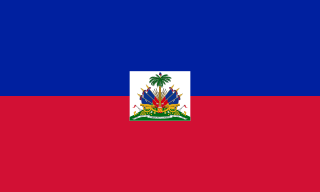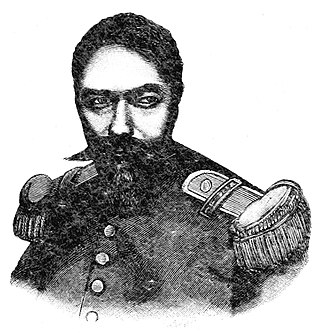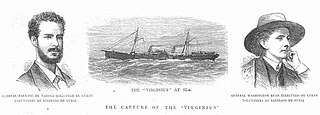
Haiti, officially the Republic of Haiti, is a country on the island of Hispaniola in the Caribbean Sea, east of Cuba and Jamaica, and south of The Bahamas. It occupies the western three-eighths of the island which it shares with the Dominican Republic. Haiti is 27,750 km2 (10,714 sq mi), the third largest country in the Caribbean, and has an estimated population of 11.4 million, making it the most populous Caribbean country. The capital is Port-au-Prince.

The seventh USS Washington (ACR-11/CA-11/IX-39), also referred to as "Armored Cruiser No. 11", and later renamed Seattle and reclassified CA-11 and IX-39, was a United States Navy Tennessee-class armored cruiser. She was laid down on 23 September 1903 at Camden, New Jersey, by the New York Shipbuilding Corporation, launched on 18 March 1905, sponsored by Miss Helen Stewart Wilson, daughter of United States Senator John L. Wilson of Washington state, and commissioned at the Philadelphia Navy Yard on 7 August 1906, Captain James D. Adams in command.

Sylvain Salnave was a Haitian general who served as the President of Haïti from 1867 to 1869. He was elected president after he led the overthrow of President Fabre Geffrard. During his term there were constant civil wars between the various factions. Eventually, he was overthrown in a coup by his eventual successor Nissage Saget, and Salnave was tried for treason and executed.

The Virginius Affair was a diplomatic dispute that occurred from October 1873 to February 1875 between the United States, Great Britain, and Spain during the Ten Years' War. Virginius was a fast American ship hired by Cuban insurrectionists to land men and munitions in Cuba to attack the Spanish regime there. It was captured by the Spanish, who wanted to try the men onboard as pirates and execute them. The Spanish executed 53 men but stopped when the British government intervened.

USS Yankee was originally El Norte, a steamer launched 14 June 1892 and delivered 15 August 1892 at Newport News, Virginia, by the Newport News Shipbuilding & Drydock Co. for the Southern Pacific Railroad's Morgan Line. The ship was acquired by the United States Navy from the Southern Pacific Company on 6 April 1898. The ship was renamed and commissioned at New York on 14 April 1898, Commander Willard H. Brownson in command.

The Dominican War of Independence was a war of independence that began when the Dominican Republic declared independence from the Republic of Haiti on February 27, 1844 and ended on January 24, 1856. Before the war, the island of Hispaniola had been united for 22 years when the newly independent nation, previously known as the Captaincy General of Santo Domingo, was unified with the Republic of Haiti in 1822. The criollo class within the country overthrew the Spanish crown in 1821 before unifying with Haiti a year later.

USS Topeka (PG-35) was a gunboat of the United States Navy.

Jean-Nicolas Nissage Saget succeeded Sylvain Salnave as President of Haiti in 1869. Coming into power by coup, Saget was the first Haitian president to serve out his term of office (1869–1874) and retire voluntarily, although his retirement led to a renewal of the political turmoil between blacks and the country's mulatto elites. He died in 1880.

USS De Soto was a fast wooden-hulled sidewheel steamship that saw service as a U.S. Navy gunboat during the American Civil War.

USS Galena was a wooden armed steamer in commission in the United States Navy from 1880 to 1890. She had an active career in which she operated in the North Atlantic Squadron and South Atlantic Squadron, seeing duty in the Mediterranean Sea and Aegean Sea, along the east coast of South America, in the Caribbean, in the waters of Canada, and along the United States East Coast and United States Gulf Coast.

The Third Battle of Manzanillo was a naval engagement that occurred on July 18, 1898, between an American fleet commanded by Chapman C. Todd against a Spanish fleet led by Joaquín Gómez de Barreda, which occurred during the Spanish–American War. The significantly more powerful United States Navy squadron, consisting of four gunboats, two armed tugs and a patrol yacht, overpowered a Royal Spanish Navy squadron which consisted of four gunboats, three pontoon used as floating batteries and three transports, sinking or destroying all the Spanish ships present without losing a single ship of their own. The victory came on the heels of a more significant American success at the Battle of Santiago de Cuba, and was the third largest naval engagement of the war after Santiago de Cuba and the Battle of Manila Bay.

The Exposition internationale du bicentenaire de Port-au-Prince was a world's fair held in Port-au-Prince, Haiti in 1949 to mark the 200th anniversary of the city's founding.
The Markomannia incident was a conflict between Haitian rebels and the German Empire in 1902, sparked by the boarding of the Hamburg steamer Markomannia by rebel naval forces.
The American steamer Ozama, 1028 tons, was the former British steamer Craigallion, built by Ramage & Ferguson in 1881 at Leith, Scotland. She had a colorful history, with a mutiny and gunrunning. She was shipwrecked twice, the first time in 1885 in the Bahamas, and the last in 1894 on the outer shoal of Cape Romain, South Carolina. She was named for the Ozama River in Santo Domingo, Dominican Republic, which was one of her regular ports of call.
SS Haiti was a passenger and freight ship built for the Colombian Mail Steamship Company built at Newport News Shipbuilding, Newport News, Virginia and delivered 15 December 1932. The ship was renamed briefly Puerto Rico in 1938 and Monterey in 1939 to operate for the New York and Cuba Mail Steamship Company until requisitioned with transfer of title to the War Shipping Administration (WSA) on 25 September 1942. The ship was then allocated to the U.S. Army for operation under a bareboat agreement as USAT Monterey. In 1943 the ship was assigned to the command at Trinidad to supply bases in Brazil and Ascension Island. After layup in the reserve fleet the ship was sold to Turkey.
Pierre André Frier Roche, France 1836- Port-au-Prince 1879) was a French military and musician known for his involvement in the military campaigns of Haitian president Fabré Geffrard and the Dominican president Buenaventura Baez during the second half of the 19th century in Hispaniola.

The Môle Saint-Nicolas affair was an 1891 diplomatic incident between Haiti and the United States when in an act of gunboat diplomacy, President of the United States Benjamin Harrison ordered Rear-Admiral Bancroft Gherardi to persuade the cession or lease of Môle Saint-Nicolas to the United States in order to establish a naval base for the United States Navy. Following a prolonged request for Gherardi's diplomatic credentials and increased public pressure, Haiti refused the request of the United States.

Cuba-Haiti relations refer to the bilateral relations between Cuba and Haiti. Cuba has an embassy in Port-au-Prince and Haiti has an embassy in Havana.

USS Wompatuck (YT-27) was an armed tug in commission in the United States Navy from 1898 to 1931. Early in her naval career, she saw combat in the Spanish–American War and the Philippine–American War. After she was decommissioned, she was selected for conversion into the fuel oil barge YO-64, but she was lost in the early days of World War II in the Pacific before the conversion could be completed.

German–Haitian relations date back to the time before the country's independence. They were characterized by trade in the 19th century. In the 20th century, they lost importance due to political developments in both Germany and Haiti.















